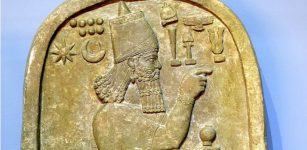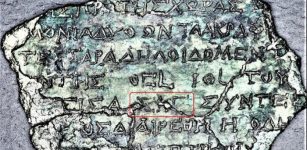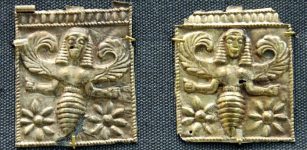Lost Ancient Golden City Of Vineta – The Atlantis Of The North
Ellen Lloyd - AncientPages.com -Many have tried to find the legendary ancient golden city of Vineta, but the place's location remains an unsolved mystery.
Did Vineta really exist, or was it only a mythical city? Do the ancient ruins of Vineta lie hidden somewhere beneath the water of the Baltic Sea?
Ancient stories tell that Vineta was once a prosperous trading center on the Baltic Coast. During the late 12th century, it disappeared beneath the water. Legend tells Vineta's inhabitants ignored omens of a coming disaster, and the city was submerged as punished for moral decay.
Today, Vineta has become known as the Atlantis of the North, and people still go to the beach hoping to catch a glimpse of the ancient underwater city.
Vineta Was A Prosperous Ancient Trading Center
According to legends, Vineta was visited by traders from many corners of the world. It was one of the most important ancient commercial cities in Europe, visited by Vikings, Slavs, Spaniards, Saxons, people from the Mediterranean, and business people from surrounding Baltic regions.
Before Vineta was submerged it was a major trading center. Credit: Adobe Stock - Sophia
The ancient city of Vineta flourished, and news about the town reached people in distant parts of the world. Ibrahim Ibn Yaqub, a 10th-century Hispano-Arabic, Sephardi Jewish traveler, who was probably a merchant and may also have been engaged in diplomacy and espionage, described it as "a large city by the ocean with twelve gates, the greatest of all cities in Europe, farthest northwest in the country of Misiko (Poland) in the marshes by the sea.
It is said that Vineta had a population of at least 50,000 inhabitants, and the city was even more prosperous than Constantinople.
Warnings Of A Coming Disaster Were Ignored
According to legend, three months, three weeks, and three days before the city's destruction, all people were warned of the coming catastrophe. Strange bright lights were seen in the sky, and a wailing mermaid appeared. The water woman cried three times in a high, startling voice:
"Vineta, Vineta, you rieke town, Vineta sall untergahn, wieldse se het väl Böses dahn"
Credit: Adobe Stock - Nejron Photo
"Vineta, Vineta, rich city, Vineta is to be destroyed because she has done much evil."
Even today, bells from the depths of the sea will be heard.
Elders advised everyone to leave the city, but everyone was reluctant to abandon a place famous for its gold and wealth. The inhabitants of Vineta lacked modesty and had become greedy.
The city of Vineta was deluged in 1170 and vanished beneath the waves of the Baltic Sea. It was believed that Vineta had been destroyed as punishment for immorality.
Where Is Vineta – The Atlantis Of The North?
The location of Vineta remains controversial, and there are many disagreements about where the legendary city was situated.
Some researchers have suggested that Vineta may have been on Wolin, an island surrounded by the Baltic Sea to the north and the Dziwna River to the east. Archaeological excavations have revealed that Wolin was once a major Viking trading center.
Jomsvikings were elite warriors who trained at Jomsborg.
Colored copperplate engraving from 1590 by Braun and Hogenberg (which is probably the oldest pictorial depiction of the town Barth. Image credit: Barth Stadt
According to intriguing stories told in the Icelandic Sagas, courageous Norse warriors were based at Jomsborg, a fortress on the south on the southern Baltic shore where Jomsvikings had their headquarters.
Jomsborgs has never been found, and there is insufficient evidence to claim Vineta on the island of Wolin. According to historian Wilhelm Ferdinand Gadebusch, Wolin needed the deep water port Vineta must have had.
Another possible location of Vineta is Usedom. Its nickname is Sunshine Island, and it is located between Germany and Poland in the Baltic. However, there is very little evidence of Slavic habitation in the area, making it unlikely this could have been Vineta. Several maps published between 1633 and 1700 have the sunken "Wineta" east of the island of Ruden northwest of Usedom.
This idea may have originated in the All Saints' Day flood of 1304, to which most of the Ruden and the then-existing connection to Mönchgut on Rügen fell victim.
It has also been speculated that Barth, a medieval town on a lagoon in northeastern Germany, is linked to the legendary golden city of Vineta. Barth was an important trade center during the Middle Ages.
Since 1999, the City of Barth has been allowed to call itself the City of Vineta. Two scientists from Berlin have suggested that Berlin, the "Atlantis of the North," be in the mud of Barth Bodden (Barth lagoon), but it has not been officially confirmed that this is the actual location of Vineta.
Whether the story of the golden city of Vineta is a mere myth or based on actual events can only be determined once the ancient ruins are finally discovered.
Written by Ellen Lloyd - AncientPages.com
Updated on January 2, 2024
Copyright © AncientPages.com All rights reserved. This material may not be published, broadcast, rewritten or redistributed in whole or part without the express written permission of AncientPages.com
Expand for referencesMore From Ancient Pages
-
 Stele Of Tell al-Rimah And Deeds Of Assyrian King Adad-nirari Against Rebellious Kings
Featured Stories | Feb 22, 2022
Stele Of Tell al-Rimah And Deeds Of Assyrian King Adad-nirari Against Rebellious Kings
Featured Stories | Feb 22, 2022 -
 America’s Ancient “Mystery Stone” Remains An Unexplained Puzzle
Artifacts | Apr 17, 2014
America’s Ancient “Mystery Stone” Remains An Unexplained Puzzle
Artifacts | Apr 17, 2014 -
 Mystery Of Ancient Carved Shiva Lingas In India And Cambodia
Featured Stories | Oct 12, 2015
Mystery Of Ancient Carved Shiva Lingas In India And Cambodia
Featured Stories | Oct 12, 2015 -
 Ancient Mystery Of The Menorah – Enigmatic Sacred Object With Complex History
Featured Stories | Nov 5, 2018
Ancient Mystery Of The Menorah – Enigmatic Sacred Object With Complex History
Featured Stories | Nov 5, 2018 -
 Humans Have Been Predicting Eclipses For Thousands Of Years, But It’s Harder Than You Might Think
Archaeology | Apr 20, 2023
Humans Have Been Predicting Eclipses For Thousands Of Years, But It’s Harder Than You Might Think
Archaeology | Apr 20, 2023 -
 Bees – Embodiment Of Human Soul, Divine Messengers Symbolizing Invisible Bridge Connecting Life And Death
Featured Stories | Jul 26, 2023
Bees – Embodiment Of Human Soul, Divine Messengers Symbolizing Invisible Bridge Connecting Life And Death
Featured Stories | Jul 26, 2023 -
 Kiln Was Invented In Mesopotamia Around 6,000 B.C.
Ancient History Facts | Mar 7, 2018
Kiln Was Invented In Mesopotamia Around 6,000 B.C.
Ancient History Facts | Mar 7, 2018 -
 Missing Lines From Epic Of Gilgamesh Shed New Light On Humbaba
Artifacts | Oct 9, 2015
Missing Lines From Epic Of Gilgamesh Shed New Light On Humbaba
Artifacts | Oct 9, 2015 -
 Somalia’s Legacy: Laas Geel Caves Covered With At Least 5,000-Year-Old Paintings
Civilizations | Oct 18, 2018
Somalia’s Legacy: Laas Geel Caves Covered With At Least 5,000-Year-Old Paintings
Civilizations | Oct 18, 2018 -
 10 Types Of Ancient Crosses In Different Cultures Explained
Featured Stories | May 23, 2017
10 Types Of Ancient Crosses In Different Cultures Explained
Featured Stories | May 23, 2017 -
 Lunar Society: Great Scientists Of The 18th Century Who Changed The World
Featured Stories | Jul 13, 2018
Lunar Society: Great Scientists Of The 18th Century Who Changed The World
Featured Stories | Jul 13, 2018 -
 Riddle Of Brazilian Atlantis – Strange Discovered Rocks The World Forgot About
Featured Stories | Jan 28, 2022
Riddle Of Brazilian Atlantis – Strange Discovered Rocks The World Forgot About
Featured Stories | Jan 28, 2022 -
 Mysterious Etruscans: Skilled Sailors And Master Craftsmen
Civilizations | Mar 1, 2016
Mysterious Etruscans: Skilled Sailors And Master Craftsmen
Civilizations | Mar 1, 2016 -
 Archaeologists Have Discovered A Mummy Wrapped In Gold – Here’s What It Tells Us About Ancient Egyptian Beliefs
Featured Stories | Feb 7, 2023
Archaeologists Have Discovered A Mummy Wrapped In Gold – Here’s What It Tells Us About Ancient Egyptian Beliefs
Featured Stories | Feb 7, 2023 -
 Evidence Scots And Irish Settled Iceland A Century Before The Vikings?
Featured Stories | Jan 7, 2023
Evidence Scots And Irish Settled Iceland A Century Before The Vikings?
Featured Stories | Jan 7, 2023 -
 Advent: Facts And History About The Christian Season Celebration
Ancient Traditions And Customs | Dec 1, 2023
Advent: Facts And History About The Christian Season Celebration
Ancient Traditions And Customs | Dec 1, 2023 -
 Controversial Ancient Takenouchi Documents Could-Re-Write Our History – Story Of Gods, Lost Continents And Ancient Sages
Featured Stories | Apr 28, 2017
Controversial Ancient Takenouchi Documents Could-Re-Write Our History – Story Of Gods, Lost Continents And Ancient Sages
Featured Stories | Apr 28, 2017 -
 Unexplained Phenomenon In Ancient Ireland – When Legends, Science And Real Events Collide
Featured Stories | Apr 19, 2018
Unexplained Phenomenon In Ancient Ireland – When Legends, Science And Real Events Collide
Featured Stories | Apr 19, 2018 -
 Centuries-Old Hunt For Vanished Treasures
Artifacts | Nov 8, 2018
Centuries-Old Hunt For Vanished Treasures
Artifacts | Nov 8, 2018 -
 Mysterious Ancient Rulers With Elongated Skulls – Who Were They Really?
Featured Stories | May 19, 2015
Mysterious Ancient Rulers With Elongated Skulls – Who Were They Really?
Featured Stories | May 19, 2015




